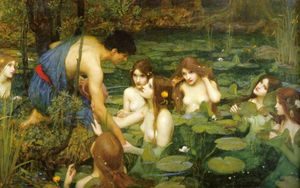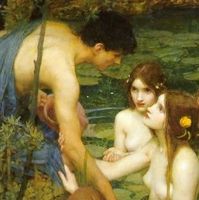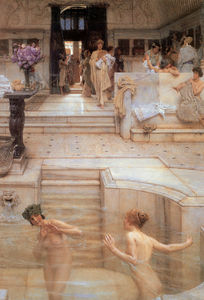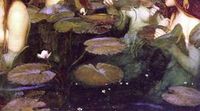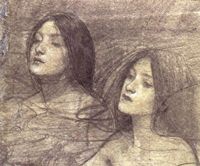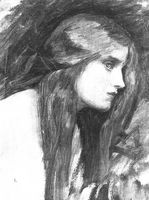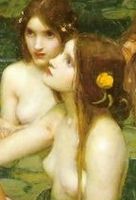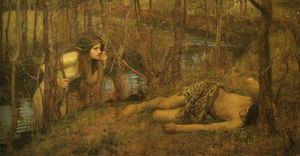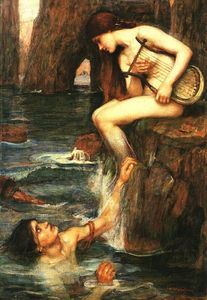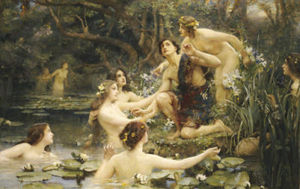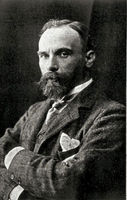Hylas and the Nymphs
- Date of Creation:
- 1896
- Height (cm):
- 132.10
- Length (cm):
- 197.50
- Medium:
- Oil
- Support:
- Canvas
- Subject:
- Fantasy
- Framed:
- No
- Art Movement:
- Romanticism
- Created by:
- Current Location:
- Manchester, United Kingdom
- Displayed at:
- Manchester City Art Gallery
- Owner:
- Manchester City Art Gallery
- Hylas and the Nymphs Page's Content
- Story / Theme
- Inspirations for the Work
- Analysis
- Critical Reception
- Related Paintings
- Artist
- Art Period
- Bibliography
Hylas and the Nymphs Story / Theme
As with many of the romantic artists Waterhouse has taken inspiration from classical tales of love and tragedy, in this case the tale of Hylas and the Nymphs. Although this story is a rather small part of the legend of Jason and the Argonauts and their search for the Golden Fleece it is nevertheless one of Waterhouse's most accomplished pieces. The artist never left any indication of why he chose this subject, although the natural setting, the nymphs and the women with mystery and power, are similar themes to those which appear in Waterhouse's other works and are obviously something which appealed to him.
Greek Mythology:
Taken from the story of Jason and the Argonauts, Hylas was an Argonaut warrior and the assistant and lover of Herlkas. He was also known to be a very handsome youth.
When Jason's boat landed on an island during his search for the Golden Fleece, Hylas was sent to fetch water for the camp. Finding a pool in a clearing, he reached down and put his pitcher into the water. Before he could lift his pitcher he looked up to discover water nymphs encircling him. Drawn by his beauty, one of the nymphs reached up to kiss Hylas.
The tale stops there and Hylas disappeared without trace from that moment, it was said that Herlkas searched the island for his beloved, in fact such a time passed that the boat left without him.
Hylas and the Nymphs Inspirations for the Work
John William Waterhouse had many inspirations around him growing up in his father's art studio. The inspiration he found in classical and pre-Raphaelite artists is also plain to see in his composition of 'Hylas and the Nymphs' as well as the very unique stamp he put on this work himself and his fascination with the captivating female form.
Classical Style:
As a young artist Waterhouse was heavily influenced by classical artists such as Alma-Tadema and Lord Leighton. The inspiration he took from these artist and others of the same period is reflected in the theme of this painting, a classical tale, as well as the styling of the characters and the composition.
Alma-Tadema's painting, 'A Favorite Custom' which he painted in 1909, has a completely different story to that of Waterhouse's work, and yet its main focus is of the two female-nudes at the forefront of the painting, very similar thematically to 'Hylas and the Nymphs'.
Femme Fatale:
The central character of this story, Hylas, is not the main focus of Waterhouse's painting. Instead, the viewer is drawn to the central Nymph. Not only does Hylas have his back to the viewer but Waterhouse has created this painting so that we almost feel like we are seeing the vision from Hylas' perspective.
The inspiration for this type of perspective come from Waterhouse's obsession with portraying a femme fatale.
Hylas and the Nymphs Analysis
Hylas and the Nymph's was created by Waterhouse in 1896. With his reputation already intact, this painting is not thought to have been produced by commission. Rather the artist created it out of his own wanting and was lucky enough to have it bought by Manchester Art Gallery shortly after its completion. The realistic way in which the artist paints the figures contrast with his otherworldly subject matter and this picture had been described by some critics as the Waterhouse's most accomplished classical work.
Composition:
Waterhouse incorporates a large number of figures in this composition and uses his skills as an artist to keep a large amount of detail in the background without it becoming too complicated and detracting from the central figures.
The Nymphs encircle Hylas, signifying the fact that he is doomed to follow them into the water. The faces of the female figures range from deep concentration to idleness.
The translucent water and the nude appearance of each nymph touches upon the gentle sexuality of these figures naked and alluring in the water. They are otherworldly to a point and Waterhouse manages to create a haunting sensuality in this painting by the identical looks of the nymphs and Hylas's position. The young man, bent forward leads the viewer to also look closer at the nymphs.
Color:
The luminous color of the Nymph's skin contrasts with their titan hair and the luscious colors of their natural surroundings.
Hylas stands out due to his darker, olive skin and rich clothing. Although the story of Hylas describes him as an incredibly handsome man, Waterhouse's color scheme and composition is as such that the viewers eyes are immediately drawn to the central nymphs, perhaps hypnotizing the viewer in the same way that Hylas himself was captured by them.
Light:
Waterhouse creates light in this picture by using the luminous cream tones of the Nymphs skin as well as thick lilac brush strokes on the water-doused Lilly pads which can be seen throughout the painting.
The otherwise darkness of the woodland surrounding the pool indicates the danger that Hylas finds himself in.
Method:
Waterhouse used models to create his realistic style and Hylas and the Nymph's was no exception. Due to the uncharacteristically large number of figures in this painting and the fact that most of them are underwater, it is impossible that Waterhouse set up this scene in his studio. However, there are several studies, done in pencil, currently in the possession of the Ashmolen Museum, in Cambridge, England, which show the development of several of the Nymph figures and were undoubtedly based on real models.
The similarity of these models to the finished painting shows the importance to Waterhouse of this process of sketch studies.
Hylas and the Nymphs Critical Reception
Hylas and the Nymphs is not one of Waterhouse's most well known works to date, however it is a prime example of his skill as an artist and there for has received very little negative comment since its completion in 1896.
In fact the modern critic and dealer Christopher Wood describes this painting in his book, Olympian Dreamers, as Waterhouse's "greatest classical picture", he goes onto say: 'Waterhouse chooses a moment of feminine agency; in this case, the Nymphs lure Hylas into their lily pond. He is the victim to their desires, and as such Waterhouse subordinates him in the painting Hylas faces away from the viewer, and the shadow cast across his face evokes a marked contrast with the illuminated faces and bodies of the Nymphs. '
Hylas and the Nymphs Related Paintings
Hylas and the Nymphs Artist
John William Waterhouse was a Romantic artist in the truest sense. His passion for a natural setting and his love of strong and beautiful female figures made his work truly unique and extremely popular with his patrons. His paintings of classical and mythical scenes show a true mix between Neoclassical themes and Romantic style which would develop through other artists in the rest of the 19th century.
Waterhouse led a relatively quiet life, one without any evidence of major drama or upset, and instead created beautiful works of art which illustrated tales of love and tragedy.
As with many of the romantic artists Waterhouse took inspiration from classical tales of love and tragedy, and this is true of Hylas and the Nymphs. Although this story is a rather small part of the legend of Jason and the Argonauts and their search for the Golden Fleece it is nevertheless one of Waterhouse's most accomplished pieces.
The artist never left any indication of why he chose this subject, although the natural setting, the nymphs and the women with mystery and power, are similar themes to those that appear in Waterhouse's other works.
Hylas and the Nymphs Art Period
John William Waterhouse was born in the mid 19th century, at a time when the Industrial Revolution was in full swing and poverty was rife within the poorer communities of his native country of England. In the art world, many professionals were rebelling against the pure and realistic lines of the Neoclassical period to have come before them and they started to produce paintings and sculpture which took the viewer into a new world, far removed from the realities of everyday life.
Hylas and the Nymphs Bibliography
Many books have been written about Waterhouse's work and listed below is a selection of some recommended reading.
• Lambourne, Lionel. The Nude and Classicism. London: Phaidon, 1999
• Nunn, Pamela Gerrish. Problem Pictures: Women and Men in Victorian Painting. Guildford: Scolar Press, 1995
• 'Waterhouse. John William Waterhouse' by Aubrey Noakes, 2004
• 'J. W. Waterhouse: The Modern Pre-Raphaelite' by Peter Trippi, Elizabeth Prettejohn, Robert Upstone, and Patty Wageman , 2009
• 'J. W.Waterhouse' by Anthony Hobson,1993
• 'J. W. Waterhouse. Illustrations in colours' by Rose E. D. Sketchley and John William Waterhouse ,1909.

